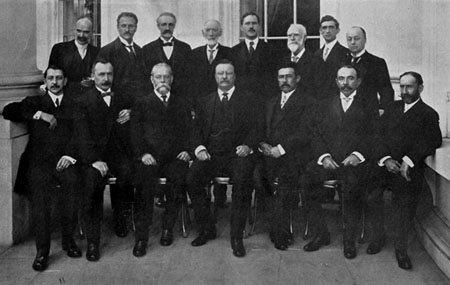February 18, 1909: North American Conservation Conference is held
In one of his last acts as president, Theodore Roosevelt convened the North American Conservation Conference on this date 101 years ago. This event might ring a bell for faithful followers of the blog. The conference and its legacy were discussed in a previous blog entry. That entry, which originally appeared as an opinion piece in the Raleigh News and Observer, focused on Gifford Pinchot’s quest for what he called “permanent peace.” There was a great deal of background that we couldn’t fit into the op-ed piece. So, given the clamoring from our fans, we’re marking the anniversary of the conference by telling, as Paul Harvey used to say, the rest of the story.
Representatives from the U.S., Canada, and Mexico — including Miguel de Quevedo, the father of Mexican conservation — attended the international conference. It was the last of three important conferences on conservation hosted by Roosevelt. The other two — the Conference of Governors, held in May 1908, and the National Conservation Commission, convened in January 1909 as a prelude to the North American conference — had for the first time focused both public and media attention on the need for conserving natural resources in the United States. The American Forestry Association chronicled the international conference in its magazine, then called Conservation, and makes mention of the ill-fated fourth one to be held in the Netherlands in September 1909. Thirty nations had already accepted invitations to attend when Roosevelt’s successor, William Howard Taft, canceled it.

Commissioners to the North American Conservation Conference. President Roosevelt sits at center, Gifford Pinchot is standing third from left, and Miguel Quevedo is seated at far right.
The catalyst behind all four meetings was Gifford Pinchot, the first chief of the U.S. Forest Service and an enormous influence on the thinking of Theodore Roosevelt. In the 1930s, he captured the attention of President Franklin Roosevelt about a world conference on conservation. Pinchot, by now governor of Pennsylvania, had been talking with FDR about the need for such an international conference when war broke out in Europe in 1939. As war clouds gathered off the shores of the United States, Pinchot began putting an emphasis on “permanent” peace.
In May 1940, Pinchot addressed the Eighth American Scientific Congress and published his paper, “Conservation as a Foundation of Permanent Peace,” in the August issue of Nature (which was reprinted in Forest History Today in 2001). Mindful of what was happening in Europe and Asia at that moment, as a path to peace he suggested that “international cooperation in conserving, utilizing, and distributing natural resources to the mutual advantage of all nations might well remove one of the most dangerous of all obstacles to a just and permanent world peace.”
U.S. entry into the war in December 1941 didn’t deter Pinchot. As can be seen in his diaries here, during the war he continued refining the ideas put forth in 1940 and presented them again to FDR in 1945 shortly before Roosevelt died. Pinchot found FDR’s successor Harry Truman equally receptive and ready to champion Pinchot’s cause. The rest, as they say, is history — or is found in a history blog.

